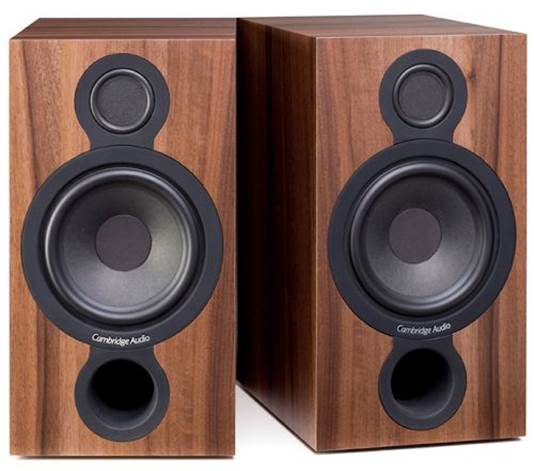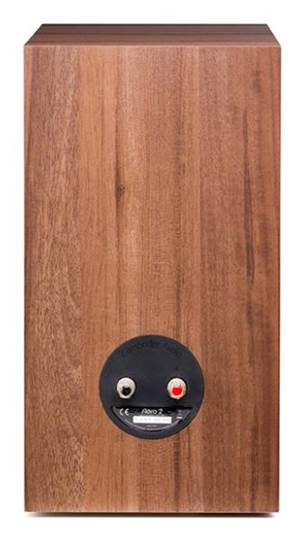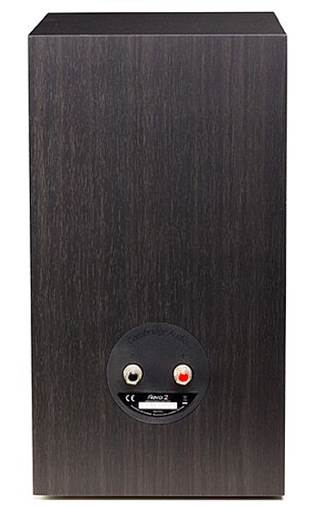Here’s a brand new small stand mount speaker with a
difference; something that’s not apparent from just looking at it.
In the bread and butter world of budget boxes, points of
difference between loudspeakers are small, yet – by marketing necessity – often
overstated. Respective models can be stylistically quite varied, but in
engineering terms all too similar. Points of divergence are really down to fine
details, ways of finessing what is ostensibly the same drive unit and cabinet
lineup to give what the designers want. True, you might get an interesting
baffle here or an unusual cone material there, but the fact remains that in the
vast majority of loudspeakers we buy, amid/bass driver will take care of the sound
from about 50Hz upwards to 2kHz or so, when a crossover will bring in a dome
tweeter that goes up to 20kHz or beyond. That’s why the new Aero 2 is so
interesting – because it doesn’t do this!

Cambridge Audio
Aero 2
Look above the woofer to the upper drive unit. Where you’d
normally see a small dome tweeter – made either from plastic, metal or fabric –
there is a Balanced Mode Radiator fitted. The BMR design came from NXT
technology developed in the nineties, which was all about producing flat panels
that make music. Various NXT panels have appeared on loudspeakers – the Mission
X-Space being an interesting example from the mists of time – but the BMR
spin-off has recently grown legs, thanks to the design’s very broad dispersion
and bandwidth capabilities. Basically, for a given size, the driver can throw
out a wider range of sound across larger parts of a room than conventional
cones or domes. They’ve proved their efficacy in all sorts of applications,
from sound bars to in-car installations – so why not put one in a small stand
mount speaker?

Cambridge Audio
Aero 2
The Aero does just this – running a 46mm BMR with a
conventional 165mm paper cone bass unit. Notice that I didn’t say ‘mid/bass’
here; if it was any other loudspeaker at this price point, I would have done
precisely this. But the Aero doesn’t have a mid/bass driver, because the
midrange is taken care of by the BMR. Here’s the clever bit – by opting for a
BMR the designer can use one single drive unit for all frequencies from 250Hz
upwards, with the bass driver handling everything below. Contrast that to a
conventional speaker, where the larger driver runs from 50Hz or so to 2 kHz,
and then the tweeter takes over. The difference is, of course, that the
crossover frequency on the Aero is way lower than any conventional speaker
using a dome tweeter – which means that it is far further away from the
ultra-critical midland, where the ear can hear any change of phase or spike or
dip in response far more clearly than it can higher up or lower down.
The genius of the Aero then – the reason it is like no other
budget loudspeaker – is that it sidesteps the problem of putting the crossover
where the ear is most sensitive. The result is that you get a bass driver
optimized for being a bass driver, and a BMR that gives you a wide expanse of
sound from upper bass to high treble – without any crossover in the way where
the ear can hear it most. Oh, and there’s more – because the BMR creates a lot
of its sound from surface vibration (like an exciter on an NXT panel) as well
as traditional in-out psionic motion, it diffuses around the room better and
doesn’t have such a pronounced sweet spot. Clever stuff, eh?

There’s no sense
of coarseness from the BMR as it spreads out around the room
The Aero’s drivers are, of course, bespoke; the BMR is the
very latest fourth-generation unit – which designer Dominic Baker says is newer
than the BMRs in any other commercially available loudspeaker currently on
sale, some of which are still running first-gen designs. It is British designed
and bespoke manufactured in China, at Cambridge Audio’s facility. The bass
driver is too, and uses paper for its cone material because the designer thinks
it’s still one of the stiffest materials relative to weight around – and a
light, but strong cone is just what’s wanted to give accurate air moving
ability.
In direct contrast to all the clever stuff that’s going on,
the cabinets themselves are pretty anodyne-looking budget boxes, although
they’re heavier and better built than they look. The designer believes that
using fancy swoopy sides – so beloved by many rivals – is more about styling
than sonic, and says that it can actually create problems, too. That’s why the
Aero gets a well-damped MDF box with a single largish reflex port on the front
baffle; there’s a choice of black or dark walnut finishes. No bowering option
is offered – again Dominic Baker believes the cost/benefit ratio of bowering
your system isn’t as good as throwing the same amount of upgrade cash at better
quality cable, rather than more of the same.

These speakers
have plenty in reserve when the music reaches a crescendo
Sound quality
The second you set ears on the Aero 2s, you realize you’re
listening to something radically different from its rivals. This little
loudspeaker has in some ways an amazing sound, offering the sort of dispersion
and evenness across the midland and treble you’d normally only get from an
electrostatic. It’s an eerie feeling of the music gelling together in an
organic way, rather than being forced out of two differing size toothpaste
tubes – and it’s lovely.
For example, play some smooth, classic funk in the shape of
Chic’s Freak Out, and what you’d normally expect from a speaker at this price
is an edgy sort of ‘boom tizzy’ sound, with the bass guitar thumping, the
cymbals crashing and those female vocals honking out at you. Try this on the
Aeros, however, and you get a far more even, balanced and subtle performance,
completely devoid of the sound of loudspeaker drive units struggling to keep
abreast of events. The midland and treble are so smooth that you can listen
right into the mix, while the bass bounces around with energy and ease,
beautifully integrated with the rest of the action. Many people – this reviewer
included – love this sort of thing, as it is totally unexpected from a pair of
$559.75 speakers; indeed in some ways it is closer to the svelte performance
you’d expect from a big 2.5-way design of a high-end floor standing speaker. It
is couth, balanced and effortlessly musical; devoid of pain or grain.